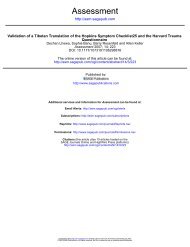From Persecution to Prison - Bellevue/NYU Program for Survivors of ...
From Persecution to Prison - Bellevue/NYU Program for Survivors of ...
From Persecution to Prison - Bellevue/NYU Program for Survivors of ...
Create successful ePaper yourself
Turn your PDF publications into a flip-book with our unique Google optimized e-Paper software.
nature and severity <strong>of</strong> these problems unanswered. As noted in the healthsection <strong>of</strong> this report, there is the possibility that at least some, if not many<strong>of</strong> the medical problems reported by our sample may have reflected psychosomaticconditions (which are common among trauma survivors)rather than organic conditions. Thus, the “failure” <strong>to</strong> provide medicaltreatment perceived by some detainees may in some cases actually reflectan appropriate response, at least with regards <strong>to</strong> medical care, <strong>to</strong> thenature <strong>of</strong> the symp<strong>to</strong>ms reported. The lack <strong>of</strong> availability <strong>for</strong> appropriatemental health services, however, still is a matter <strong>of</strong> concern in how suchsomatic symp<strong>to</strong>ms could be addressed. Un<strong>for</strong>tunately, such differentiationsare not necessarily possible given the data. The <strong>Bellevue</strong>/<strong>NYU</strong>-PHRresearchers did attempt <strong>to</strong> distinguish “medical” problems that wereovertly psychological in nature (e.g., insomnia) but many other symp<strong>to</strong>ms(pain, headaches, gastrointestinal discom<strong>for</strong>t) may have reflected psychologicalstress rather than organic etiology. How <strong>of</strong>ten such complaintswere somatic rather than organic in nature is not known.The geographic region in which the study was conducted is anotherlimitation pertaining <strong>to</strong> the study sample. This study was limited <strong>to</strong> detentioncenters in the northeastern United States and included only 70detainees. Detainees in other regions <strong>of</strong> the US may be from different parts<strong>of</strong> the world, having experienced different <strong>for</strong>ms <strong>of</strong> <strong>to</strong>rture and abuse, andmay be treated quite differently by cus<strong>to</strong>ms and detention center staff.Nevertheless, given the absence <strong>of</strong> data on detained asylum seekers nationwideand internationally, the present study provides the first attempt <strong>to</strong>obtain systematic data on the general health, psychological functioningand experiences while in detention <strong>of</strong> this group.Finally, the reliance on self-report data <strong>to</strong> assess symp<strong>to</strong>m severity,access <strong>to</strong> medical care, and treatment by Cus<strong>to</strong>ms and INS staff is anotherlimitation <strong>to</strong> consider. Despite in<strong>for</strong>ming the study participants that surveyresponses (or even participation) would not influence either their asylumclaims or their status in detention, and there would be no material or othergain by participating in the survey, the severity <strong>of</strong> psychological symp<strong>to</strong>ms,and experiences/number <strong>of</strong> abuses reported in the study may havebeen over or under reported if detainees judged that it was in their interest<strong>to</strong> exaggerate or conceal symp<strong>to</strong>ms or claims <strong>of</strong> mistreatment. For example,despite the fact that interviews were conducted in private and assurances<strong>of</strong> confidentiality were provided, individuals may have been fearful<strong>of</strong> reporting occurrences. Also, there is a subjective component <strong>to</strong> whatconstitutes verbal/physical abuse, and individuals may have under or overreported such incidents as well because <strong>of</strong> this. The narrative in<strong>for</strong>mationpresented in this study provides a useful context in which <strong>to</strong> understandthe survey response data.This study was a survey <strong>of</strong> individuals’ experiences, and it was notwithin the scope <strong>of</strong> the study <strong>to</strong> corroborate accounts <strong>of</strong> events describedSTUDY LIMITATIONS 153



